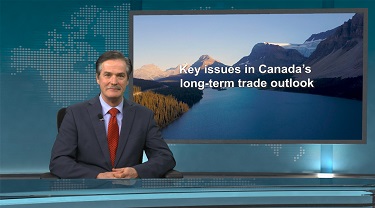Forecasting is like looking at the Earth from different vantage points. From space, the Earth seems all about perfect curves and straight lines. But the ground view reveals serious ups and downs and twists and turns that are imperceptible from above. Short-term forecasting is the closeup view of the economy, mapping out the rough day-to-day or year-to-year ride. The long term takes the high view: Sure, the twists and turns are there, but what we need to know is the final destination. Here are some of the key issues to watch for in Export Development Canada’s (EDC) long-term export outlook.
1. A rebound in Canada’s slowing GDP growth trend. Many are troubled by the multi-decade slowdown underway, and conclude that with aging demographics, the trend will inevitably continue. When considering the three pillars of long-term growth—labour, capital and productivity—EDC Economics challenges this assumption. Growth won’t likely come roaring back, but it may well break the trend of past decades if we leverage technology’s ability to do things that only labour could do until this point in history. In future, growth may well be less influenced by people power.
2. Longer business cycles. We believe that this is a modern economic reality. More open trade policies and technology have opened the global economy to countries that will be in fast-catch-up mode for years to come. These now collectively make up about 50% of global GDP, increasing overall global growth and stretching out the business cycles. We now have longer longs, higher highs, deeper downturns, and protracted pre-recovery sluggishness. This latter phase is arguably the most difficult, giving rise to today’s worldwide political and social fallout.
3. Diversification. As sustained, superior growth increases emerging markets’ share of total global GDP, economies, like Canada, that don’t want to fall behind in the global game, will have to diversify their international business activities to less-traditional and lesser-known markets. Traditional markets will continue to grow more slowly over the long-term horizon.
4. Tight labour supply. Firms in all industries and regions are complaining about the lack of available labour. Immigration is a remedy, but there’s intense global competition for skilled workers. Globalization and machine-solutions are fundamental to sustaining growth in the long term, given the labour reality. Economic benefits will increasingly be about calculating value creation, and less about job creation.
5. Rise of the service sector. Goods-production will steadily give way to the service sector through the long term. Emerging economies will join the developed world in driving this change as they also experience increased income per capita. Services have largely been non-tradable throughout history. However, technology is now leading a long-term explosion of trade in services. Now to figure out how to facilitate that trade!
6. Climate change. The increased incidence of extreme weather events has put climate change close to the top of the international agenda. Higher global growth presents a dilemma; unless energy intensity diminishes enough to more-than-offset growth, emissions will continue to rise. The pressure to reduce emissions, together with pressure on those lending to high emitters, will intensify over the next decade. Raising capital in the traditional energy sector will be more difficult to do, and energy investment portfolios will face greater scrutiny. On the flipside, this will be a boon to cleantech innovations and investments.
Other factors are also at the top of the list, including the general effects of technology on the financial world and general business efficiency; global populism and its effects; and a host of industry-specific developments, not the least of which is pressure on the world’s food supply. These and other pressing long-term issues are fast becoming part of grassroots business strategy. EDC has initiated a long-term forecasting process to enable our own 10-year planning horizon and also to assist Canadian businesses of all sizes to plan for long-term challenges and opportunities.
You should also check out
In the 2019 year-end TCI, the outlook of Canadian exporters fell to its lowest level in eight years.
The bottom line?
It’s critical for business success to keep our eyes on day-to-day developments in the economy and politics—but our ultimate destination is just as critical. Amid the risks, it’s amazing to discover the opportunities that reveal themselves.
This commentary is presented for informational purposes only. It’s not intended to be a comprehensive or detailed statement on any subject and no representations or warranties, express or implied, are made as to its accuracy, timeliness or completeness. Nothing in this commentary is intended to provide financial, legal, accounting or tax advice nor should it be relied upon. EDC nor the author is liable whatsoever for any loss or damage caused by, or resulting from, any use of or any inaccuracies, errors or omissions in the information provided.






